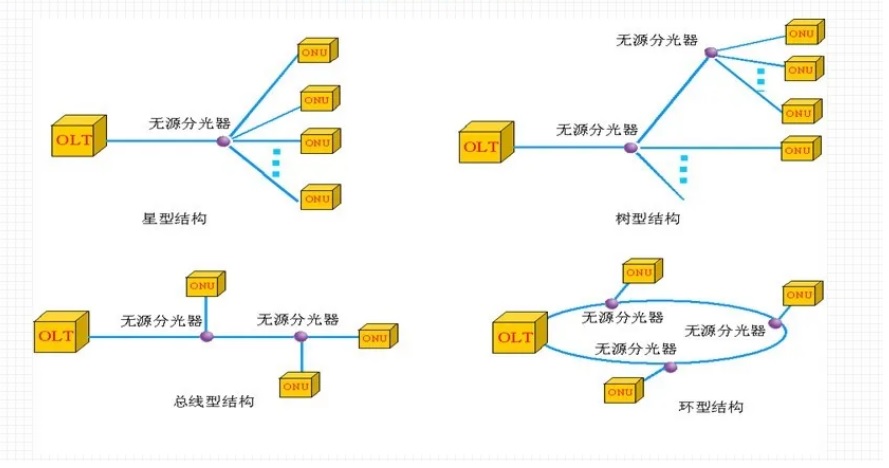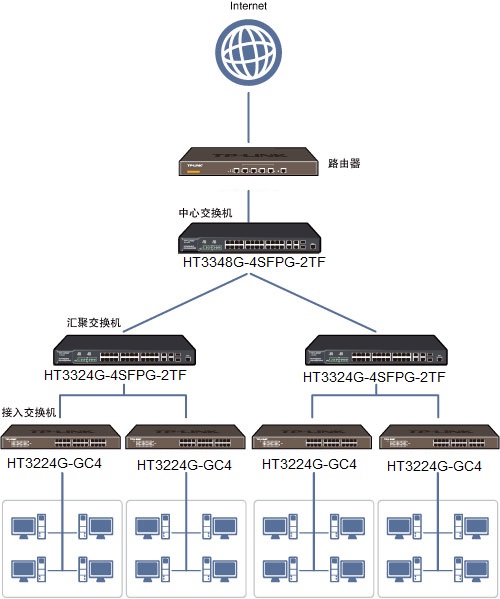Comparative analysis of Ethernet switch network and PON network
2020/4/12 11:12:07
With more and more data, voice, video and other applications, With the implementation of the policy of multi network integration, it becomes more and more urgent to break through the "bottleneck" and the access distance limit of the access network bandwidth. Only by breaking through the "bottleneck" and the access distance limit of the access network bandwidth, can the whole network effectively play the role of bandwidth, truly promote the development of various services, and bring economic and social benefits to operators. As a suitable access technology, PON (passive optical network) has been widely used in this context. As a traditional networking method, switch is widely used in enterprise network, but it can not meet the requirements of many fields, many services, high bandwidth, high reliability and high convenience. EPON / GPON networking method has attracted more and more attention and application in video monitoring, fiber to home, campus network and industrial communication network, with low cost, simple maintenance, easy expansion and easy application The features of upgrade, high security, multi service and so on are liked and trusted by operators and integrators.
The comparison between the two is as follows:
1. Principle Comparison
PON (802.3ah) is a passive optical network based on Ethernet. It carries Ethernet packets, so PON is born to serve IP. Like traditional LAN technical standards, it has invested IEEE. Data transmission principle PON uses 1490nm optical wave to carry data, OLT (optical line terminal) to ONU (optical network unit) )Point to multipoint broadcast (TDM) is adopted for inter downlink data, and ONU identifies the data of LLID in MPMC layer.
Between OLT and ONU, AES-128 is used for encryption to ensure data security. For the uplink data from ONU to OLT, TDMA is used to allocate time slots for each ONU and transmit the uplink traffic.
When the ONU is registered successfully, OLT will configure specific bandwidth to ONU according to the system configuration (with DBA, OLT will dynamically allocate bandwidth to each ONU according to the specified bandwidth allocation strategy and the status report of each ONU). For PON layer, bandwidth is the number of basic timeslots that can transmit data. The unit time length of each basic timeslot is 16nm. Under each OLT port (PON port), the clock between all onus and OLT PON ports is strictly synchronized. Each ONU can only start at the time when OLT allocates it, and transmit data with the slot length allocated to it. Through slot allocation and delay compensation, it can ensure that the packets on each ONU will not interfere with each other when the data signals of multiple onus are coupled to a single fiber.
LAN is a kind of LAN technology, which is introduced into access network because of its simple technology and wide use.
At present, LAN technology is mainly Ethernet, especially ieee802.3u and ieee802.3z/ab are widely used. Ethernet using CSMA / CD (Carrier Sense Multiple Access with collision monitoring) is a sharing technology.
In this technology, the devices at both ends are equal, and both sides use the same mechanism to transmit data flow. The data exchange between the terminal and the terminal is transmitted completely according to MAC on the switch, and the data is transmitted by CSMA / CD. The emergence of VLAN solves the problem of conflict and broadcast.
Bandwidth and transmission distance LAN Ethernet currently achieves a symmetrical access rate of 10 / 100 / 1000mbit / s, but it can only provide a transmission distance of 200m at most, which is also one of the biggest problems of its access technology. Generally, it is intelligent to extend the transmission distance through a cascade switch.
PON can also achieve a symmetrical access rate of 10 / 100 / 1000mbit / s, but it can guarantee a transmission distance of up to 20km, completely overcome the limitations of Ethernet and xDSL technology in distance and bandwidth, and make the broadband access scheme cover a wider range.
The networking capability is that the expandable LAN equipment is placed in the office building or the community, and connected with users through five kinds of lines, which involves the wiring engineering cost in the building.
Experience shows that the equipment and cabling in the early stage occupy a lot of manpower and material resources, and the deployment switch in the early stage of LAN access is in place at one time. If there is an error in the prediction of the number of users, it will cause the port to be idle for a long time, and it may also cause the port shortage and expansion trouble in some areas.
LAN is the point-to-point access technology of the system, which only supports point-to-point information transmission, so the networking has limitations. If there is broadband access demand along the long and narrow strip, it is necessary to deploy switches at each demand point to integrate into the convergence switch at the office end, or place a secondary convergence device at each demand point, which provides the port and connects the switch traffic at the demand point. If EPON Technology is adopted, it is much faster to solve the demand.
PON is a point-to-multipoint access technology. It can realize flexible networking and support tree, star, chain and other forms of networking by combining the optical splitters with different optical ratio. Along the narrow and long strip with broadband access requirements, place a 1:2 passive splitter at each demand point, plan a certain bandwidth, continue to lay optical cable forward, and also place a 1:2 passive splitter at the next demand point, so that all information nodes can be easily accessed.
EPON also has obvious advantages in supporting star networking. Placing a 1:n optical splitter in ODN can cover access of up to 64 information points, and the maximum coverage radius is 20km.
PON products are mainly in OLT and ONU, OLT is arranged at the machine room end, and a set of OLT can cover a wide area. The passive equipment in the middle is cheap and can be deployed in place at one time. ONU can be expanded with the development of business. And ONU registration on OLT is automatically completed, so when an area needs to add ONU, you can directly join the network.
2. Networking comparison
2.1 as an access technology, PON usually has FTTH (fiber to home), FTTB (fiber to building) and other networking schemes. FTTH has high unit cost and is suitable for a few high-end individual users and unit customers. FTTB scheme is the most suitable for general users in terms of unit cost and access broadband, so it focuses on the comparative analysis of the implementation of FTTB scheme.

2.2 Ethernet technology has the advantages of good scalability, low price, high access rate, mature and simple, and can provide users with 10 / 100mbit / S terminal access rate. Especially for the high-density user group, the economy of Ethernet access is also very good, and due to the high residential density of urban residents in China, it is just suitable for this feature of Ethernet access.

In commercial buildings and residential areas, Ethernet access is still a promising broadband access method, and end-to-end Ethernet service also represents a development direction of communication technology. PON products fully inherit the advantages of Ethernet technology. ONU provides Ethernet interface, which can directly provide users with 10 / 100mbit / S terminal access rate.
Same point:
1) The office needs large capacity convergence equipment. LAN mode is convergence plus switch, and PON mode is OLT device.
2) A meeting point is needed in the middle. LAN mode is the park convergence or building convergence switch, and PON mode is POS.
3) Provide 10 / 100mbit / s Ethernet interface for users. LAN mode is provided with 10 / 100mbit / s Ethernet interface by corridor switch, and PON mode is provided with 10 / 100mbit / s Ethernet interface by ONU.
4) Both methods need to occupy optical cable resources.
Difference:
1) Traditional LAN mode occupies two core optical cable, PON occupies single core optical cable.
2) Traditional LAN mode requires multi-level convergence switch, PON uses passive optical splitter.
3) The traditional LAN mode is multi-level aggregation, which leads to low bandwidth utilization due to the complexity of the layer. The PON mode has simple layer and high bandwidth utilization. The main factors that affect the development of communication technology are cost and bandwidth, that is, the input of unit bandwidth is the decisive factor. Compared with LAN access technology, PON not only saves optical fiber resources, but also provides active equipment with time between the local and the user, which is simple in maintenance and high in reliability, thus reducing the overall network cost. The FTTB networking scheme well integrates the advantages of Ethernet and PON network, and saves many problems in pure Ethernet, such as equipment and network management, equipment power supply, bandwidth expansion, etc. Therefore, it is an ideal Ethernet access solution that can meet the requirements of telecom level operation.
3. Investment comparison
Under the same user conditions, there are only optical passive components such as optical fiber and optical splitter between the OLT and ONU in PON + FTTB mode, without renting the machine room, power supply and active equipment maintenance personnel. Therefore, the construction cost should be reduced by at least 20%, and the maintenance cost in the later period should be reduced by 50%;
The LAN mode needs to build computer room, establish independent power supply and maintenance personnel, and the relative operation and maintenance cost is much higher than the PON mode. From the above analysis, it can be seen that PON technology is used to achieve data symmetrical transmission, with a natural mechanism of limiting broadcast and conflict, to meet the requirements of operators to provide users with a bandwidth of 1m-1ge according to flexible tariff mode, and DBA (database management) technology greatly improves the utilization rate of bandwidth;
It can provide the access capability with a radius of 20km, greatly improve the coverage, and thoroughly solve the broadband access problem in remote areas;
A large number of backbone optical fibers and optical transceivers are formed; network passive equipment saves power, anti-theft and lightning protection, does not need two-layer aggregation switch investment, does not need machine room construction, has high reliability, and significantly reduces maintenance costs;
This is the advantage of PON for traditional LAN access.
Conclusion:
PON networking mode: PON eliminates the active equipment between the office and the user, which makes the maintenance simple, high reliability and low cost; with strong scalability, the integrated seamless management of the whole network is much easier than the switch in terms of operation and maintenance and operability, and PON only needs to expand the capacity of OLT and ONU devices to achieve rapid upgrade of access bandwidth. Ethernet needs to be replaced and upgraded step by step, which costs a lot of manpower and material resources. With the development of EPON / GPON technology and the promotion of Internet technology, PON networking will be widely used in more and more fields.



